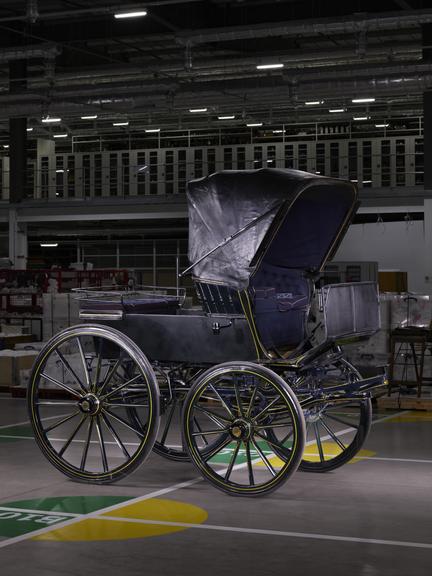Hooded mail phaeton, by Holland and Holland
This Hooded Mail Phaeton is a 4 wheeled carriage built by Holland and Holland coachmakers in London during the late 19th century.
It can seat up to four people (including the driver) across two front seats under a foldable black leather hood, and two unprotected seats at the back (sometimes called rumble seats). This carriage would be pulled by a pair of horses.
The mail phaeton has four grasshopper springs (the kind used on mail coaches), two of which are fixed at the rear via a cross-spring, and two fixed at the front.
The carriage is painted dark blue with yellow lining (the livery of Sir John Miller, ex-royal equerry at the Buckingham Royal Mews), although this is not original. It has padded seating with blue velvet cushions with a yellow/gold trimming. The front seats are protected by a metal and black leather dash, which protects the front passengers from stones and mud kicked up by the horse/horses. The driver has access to a foot pedal which controls the spoon brakes that will stop the carriage. The wheels have brass hub caps which are engraved “Holland & Holland, London, W”.
More
Phaetons were one of the most popular and common types of carriages seen in Victorian society and were one of the first carriages designed explicitly to be owner-driven. There are many variations of phaeton designed for different purposes.
Hooded mail phaetons like this one are defined by their foldable leather hood, and their two sets of grasshopper springs. Grasshopper springs are not typical for phaetons, which are generally driven slowly for luxury strolls. These types of springs are installed for carriages that are going to be driven much quicker, and across rougher ground, and were originally found on mail coaches which travel between cities on country roads carrying passengers and mail. Hooded mail phaetons were named because of their use of these grasshopper springs but had nothing to do with the mail and were actually built for sport.
This Hooded Mail Phaeton was built in the late 19th century by Holland and Holland, a coachbuilders founded between 1850 and 1860 in London. They produced a wide range of carriages and eventually motorcars but are perhaps best known for their production of sporting carriages such as Park Drags which were essentially sporting versions of stagecoaches and mail coaches. Holland and Holland was known for producing carriages for sporting clientele, mostly young and wealthy men, who formed driving and racing clubs in the late 19th century. Holland and Holland continued to produce sporting carriages for rich clientele well into the 20th century.
- Measurements:
-
overall: 3500 mm x 1720 mm x 2640 mm,
- Materials:
- wood (unidentified) , metal (unknown) , paint , iron , brass (copper, zinc alloy) , rubber (unidentified) , textile and leather
- Object Number:
- 1937-837/1
- type:
- phaeton
- Image ©
- The Board of Trustees of the Science Museum








